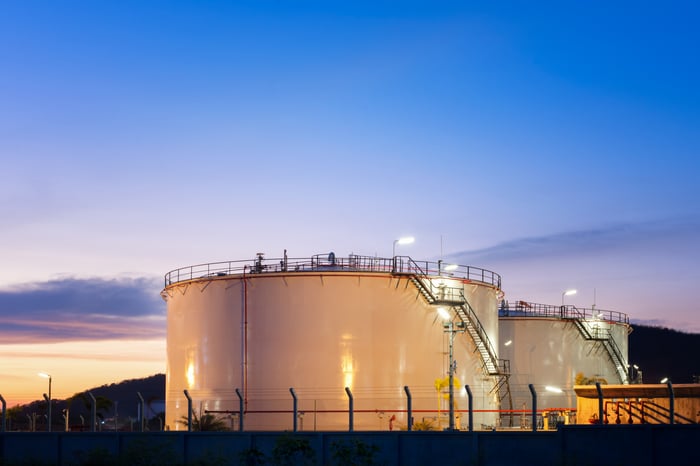Investors have all but given up on energy master limited partnerships (MLPs) in recent years because of a combination of mismanagement, sector headwinds, tax complexity, volatility, and the steady shift toward renewable energy. That means most MLPs trade at bottom-of-the-barrel valuations. As a result, their dividend yields are sky-high.
That latter point is certainly the case for Magellan Midstream Partners (MMP) and NuStar Energy (NS), which yield an eye-popping 11.2% and 13.8%, respectively. Contrarian investors can scoop up some massive yields if they're willing to take the risk. Here's a look at which of these MLPs looks like the safer bet these days.

Image source: Getty Images.
The bull and bear case for Magellan Midstream Partners
Units of Magellan Midstream Partners have lost more than 40% of their value this year, which has pushed its distribution yield up into the double digits. The main issue weighing on the MLP is the impact COVID-19 has had on demand for refined petroleum products like gasoline and diesel. With the pandemic sapping consumption, fewer volumes are flowing through Magellan's pipeline systems, leaving the company expecting to generate only $1.0 billion to $1.05 billion in cash flow this year, which is enough to cover its high-yielding distribution by 1.1 to 1.14 times. That's a bit below its targeted level of at least 1.2 and further below its initial view that it would generate $1.2 billion in cash and cover its payout by 1.25 times.
On a more positive note, the MLP has a strong balance sheet to help cushion the blow as it has one of the highest investment-grade ratings in the sector. It backs that rating with a low 3.0 debt-to-EBITDA ratio, which is below its 4.0 leverage target. It thus has plenty of financial flexibility to invest in expansion projects.
However, investment spending is winding down as the oil sector heads out of a growth phase, meaning Magellan's cash flow might not have too much more upside unless it starts making acquisitions. On the other hand, that means it should generate enough free cash flow in the coming years to cover its distribution and limited growth spending with room to spare. That would give it the funds to buy back more of its beaten-down units, which could boost its valuation.
The bull and bear case for NuStar Energy
Units of NuStar Energy have plummeted 55% this year, which drove up its distribution yield. The pandemic has also affected its operations and earnings, which has weighed on its valuation. Overall, the MLP expects its financial results to be about 6% below its pre-pandemic guidance.
This year's oil market downturn has had an outsize impact on NuStar's valuation because it has a weaker financial profile. The MLP has junk-rated credit, which affects its access to funding. For example, it had to tap the private capital market for a term loan earlier this year to shore up its liquidity at the cost of 12%. However, its balance sheet has been trending in the right direction, as it ended the second quarter with a leverage ratio of 3.94 times debt-to-EBITDA, which was the fifth straight quarter it kept leverage below 4.0. Meanwhile, the company is working to ensure its financial profile doesn't deteriorate by cutting spending and its distribution.
With that payout cut -- 33% below the previous level -- NuStar Energy boosted its coverage ratio to a more comfortable 1.43. That's allowing it to retain cash to fund expansion projects and repay debt.
Meanwhile, with the pandemic knocking the wind out of the global economy, crude oil demand is likely to remain weak through next year. That means NuStar has limited near-term growth prospects. While that means cash flow might not expand too much in the coming years, its business should generate lots of excess cash to fund its reset dividend and drive down its debt level. Once its balance sheet is in a better place, it could use its spare cash to buy back some of its beaten-down units.
Strength amid the storm
Magellan Midstream and NuStar Energy are fighting the same industry headwinds. However, Magellan is battling from a position of strength, since it has a fortress-like balance sheet thanks to its top-tier credit rating. Its sky-high distribution accordingly seems to be on a stronger footing. That makes it the more appealing buy for yield-seeking investors willing to bet that the energy sector still has some fuel left in the tank.





